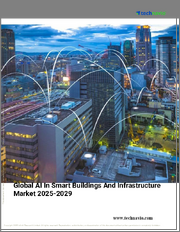
|
시장보고서
상품코드
1690019
스마트 빌딩 시장 규모, 점유율, 성장 분석 : 컴포넌트별, 솔루션별, 건물 유형별, 지역별 - 산업 예측(2025-2032년)Smart Building Market Size, Share, and Growth Analysis, By Component (Solutions, Services), By Solution (Building Infrastructure Management, Safety And Security Management), By Building Type, By Region - Industry Forecast 2025-2032 |
||||||
세계의 스마트 빌딩 시장 규모는 2023년에 1,050억 달러로 평가되며, 2024년 1,323억 달러에서 2032년에는 8,404억 7,000만 달러로 성장하며, 예측 기간(2025-2032년)의 CAGR은 26.0%로 성장할 전망입니다.
스마트 빌딩 분야는 IoT 센서와 자동화 기술을 통해 환기, 조명, 난방 및 기타 필수 서비스를 관리하는 첨단 제어 시스템을 통해 크게 성장하고 있습니다. 스마트 시티 동향 확대의 일환으로 이러한 기술은 유지보수를 간소화하고, 효율성, 안전성, 데이터 투명성을 높입니다. 디지털 기술, 통신, 센서의 혁신은 빌딩 자동화 시스템(BAS)의 취약성으로 인한 사이버 보안의 우려는 여전히 남아있지만, 매우 효과적인 빌딩 모니터링과 제어를 가능하게 합니다. 또한 스마트 빌딩은 에너지 자급자족을 향한 입지가 강화되면서 저탄소 에너지 관리 시스템에 대한 수요가 급증하고 있으며, AI와 머신러닝을 통합하여 빌딩 데이터를 분석함으로써 운영 및 매출 창출을 최적화할 수 있을 것으로 기대됩니다. 특히 중국내 스마트 시티 구상에 대한 투자가 2031년까지 389억 2,000만 달러에 달할 것으로 전망되고 있습니다.
목차
서론
- 조사의 목적
- 조사 범위
- 정의
조사 방법
- 정보 조달
- 2차와 1차 데이터 방법
- 시장 규모 예측
- 시장의 전제조건과 제한
개요
- 세계 시장 전망
- 공급과 수요 동향 분석
- 부문별 기회 분석
시장 역학과 전망
- 시장 개요
- 시장 규모
- 시장 역학
- 촉진요인과 기회
- 억제요인과 과제
- Porter의 산업 분석
주요 시장 인사이트
- 주요 성공 요인
- 경쟁의 정도
- 주요 투자 기회
- 시장 에코시스템
- 시장의 매력 지수(2024년)
- PESTEL 분석
- 거시경제 지표
- 밸류체인 분석
- 가격 분석
- 기술 분석
- 사례 연구
- 고객과 구매 기준 분석
스마트 빌딩 시장 규모 : 컴포넌트별 & CAGR(2025-2032)
- 시장 개요
- 솔루션
- 서비스
- 컨설팅
- 실장
- 지원과 정비
스마트 빌딩 시장 규모 : 솔루션별 & CAGR(2025-2032)
- 시장 개요
- 건물 인프라 관리
- 주차장 관리 시스템
- 스마트 물관리 시스템
- 엘리베이터·에스컬레이터 관리 시스템
- 안전과 보안 관리
- 액세스 제어 시스템
- 비디오 감시 시스템
- 화재 및 생명 안전 시스템
- 에너지 관리
- HVAC 제어 시스템
- 조명 관리 시스템
- 네트워크 관리
- 유선 기술
- 무선 기술
- 통합 워크플레이스 관리 시스템
- 운영과 서비스의 관리
- 부동산 관리
- 환경과 에너지 관리
- 시설 관리
- 자본 프로젝트 관리
스마트 빌딩 시장 규모 : 건물 유형별 & CAGR(2025-2032)
- 시장 개요
- 주택용
- 상업용
- 산업용
스마트 빌딩 시장 규모 & CAGR(2025-2032)
- 북미
- 미국
- 캐나다
- 유럽
- 독일
- 스페인
- 프랑스
- 영국
- 이탈리아
- 기타 유럽 지역
- 아시아태평양
- 중국
- 인도
- 일본
- 한국
- 기타 아시아태평양
- 라틴아메리카
- 브라질
- 기타 라틴아메리카 지역
- 중동 및 아프리카
- GCC 국가
- 남아프리카공화국
- 기타 중동 및 아프리카
경쟁 정보
- 상위 5사의 비교
- 주요 기업의 시장 포지셔닝(2024년)
- 주요 시장 기업이 채택한 전략
- 최근 시장 동향
- 기업의 시장 점유율 분석(2024년)
- 주요 기업의 기업 개요
- 기업의 상세
- 제품 포트폴리오 분석
- 기업의 부문별 점유율 분석
- 매출의 전년대비 비교(2022-2024)
주요 기업 개요
- Cisco(US)
- IBM(US)
- Honeywell(US)
- Siemens(Germany)
- Johnson Controls(Ireland)
- Huawei(China)
- Intel(US)
- PTC(US)
- ABB(Switzerland)
- Hitachi(Japan)
- Schneider Electric(France)
- Telit(UK)
- Legrand(France)
- Bosch(Germany)
- KMC Controls(US)
- Verdigris Technologies(US)
- 75 F(US)
- ENTOUCH(US)
- Gaia(India)
- Softdel System(US)
결론과 제안
KSA 25.04.29Global Smart Building Market size was valued at USD 105.0 billion in 2023 and is poised to grow from USD 132.3 billion in 2024 to USD 840.47 billion by 2032, growing at a CAGR of 26.0% during the forecast period (2025-2032).
The smart building sector is experiencing significant growth driven by advanced control systems that manage ventilation, lighting, heating, and other essential services through IoT sensors and automation technologies. As part of the expanding smart city trend, these technologies simplify maintenance and enhance efficiency, safety, and data transparency. Innovations in digital technology, telecommunications, and sensors enable highly effective building monitoring and control, although cybersecurity remains a concern due to vulnerabilities in Building Automation Systems (BAS). Additionally, smart buildings are increasingly positioned for energy self-sufficiency, leading to a surge in demand for low-carbon energy management systems. The integration of AI and Machine Learning to analyze building data is expected to optimize operations and revenue generation. Notably, investment in smart city initiatives, particularly in China, is poised to surpass $38.92 billion by 2031.
Top-down and bottom-up approaches were used to estimate and validate the size of the Global Smart Building market and to estimate the size of various other dependent submarkets. The research methodology used to estimate the market size includes the following details: The key players in the market were identified through secondary research, and their market shares in the respective regions were determined through primary and secondary research. This entire procedure includes the study of the annual and financial reports of the top market players and extensive interviews for key insights from industry leaders such as CEOs, VPs, directors, and marketing executives. All percentage shares split, and breakdowns were determined using secondary sources and verified through Primary sources. All possible parameters that affect the markets covered in this research study have been accounted for, viewed in extensive detail, verified through primary research, and analyzed to get the final quantitative and qualitative data.
Global Smart Building Market Segments Analysis
Global Smart Building Market is segmented by Component, Solution, Building Type and region. Based on Component, the market is segmented into Solutions and Services. Based on Solution, the market is segmented into Building Infrastructure Management, Safety And Security Management, Energy Management, Network Management and Integrated Workplace Management System. Based on Building Type, the market is segmented into Residential, Commercial and Industrial. Based on region, the market is segmented into North America, Europe, Asia Pacific, Latin America and Middle East & Africa.
Driver of the Global Smart Building Market
The Global Smart Building market is primarily propelled by the rising consumer interest in advanced building technologies that minimize operational costs, alongside a heightened awareness regarding energy consumption among individuals. As people become more knowledgeable about the benefits of energy-efficient solutions, their demand for smart building innovations continues to grow. This shift not only reflects a commitment to sustainability but also highlights a comprehensive understanding of how such technologies can contribute to significant cost savings. Consequently, these factors are critical in driving revenue growth within the industry, as they encourage investments in smarter, more efficient building practices.
Restraints in the Global Smart Building Market
The increasing frequency of cyberattacks on smart buildings poses a significant challenge to the growth of the Global Smart Building market. As more building systems and devices become interconnected through advanced technology, they become vulnerable to potential breaches. These cyber threats not only jeopardize the security of the infrastructure but also risk exposing sensitive private and personal data. This heightened concern surrounding cybersecurity can deter investment and innovation in the smart building sector, creating a major hurdle for market advancement. Consequently, addressing these security vulnerabilities is essential to foster confidence and promote growth within the industry.
Market Trends of the Global Smart Building Market
The global smart building market is poised for significant growth driven by rapid urbanization, with projections indicating that by 2050, 70% of the global population will reside in urban areas. This demographic shift creates an urgent demand for advanced infrastructure that enhances efficiency, sustainability, and occupant experience. The need for smart buildings, equipped with IoT technologies and automation systems, becomes crucial in accommodating the growing urban populace and their lifestyle demands. As cities face challenges related to resource management, safety, and energy consumption, the smart building sector is set to become a pivotal solution, catalyzing investments and innovations in building technology worldwide.
Table of Contents
Introduction
- Objectives of the Study
- Scope of the Report
- Definitions
Research Methodology
- Information Procurement
- Secondary & Primary Data Methods
- Market Size Estimation
- Market Assumptions & Limitations
Executive Summary
- Global Market Outlook
- Supply & Demand Trend Analysis
- Segmental Opportunity Analysis
Market Dynamics & Outlook
- Market Overview
- Market Size
- Market Dynamics
- Drivers & Opportunities
- Restraints & Challenges
- Porters Analysis
- Competitive rivalry
- Threat of substitute
- Bargaining power of buyers
- Threat of new entrants
- Bargaining power of suppliers
Key Market Insights
- Key Success Factors
- Degree of Competition
- Top Investment Pockets
- Market Ecosystem
- Market Attractiveness Index, 2024
- PESTEL Analysis
- Macro-Economic Indicators
- Value Chain Analysis
- Pricing Analysis
- Technology Analysis
- Case Studies
- Customer And Buying Criteria Analysis
Global Smart Building Market Size by Component & CAGR (2025-2032)
- Market Overview
- Solutions
- Services
- Consulting
- Implementation
- Support and Maintenance
Global Smart Building Market Size by Solution & CAGR (2025-2032)
- Market Overview
- Building Infrastructure Management
- Parking management system
- Smart water management system
- Elevators and escalators management system
- Safety And Security Management
- Access control system
- Video surveillance system
- Fire and life safety system
- Energy Management
- HVAC control system
- Lighting management system
- Network Management
- Wired technology
- Wireless technology
- Integrated Workplace Management System
- Operations and services management
- Real estate management
- Environmental and energy management
- Facility management
- Capital project management
Global Smart Building Market Size by Building Type & CAGR (2025-2032)
- Market Overview
- Residential
- Commercial
- Industrial
Global Smart Building Market Size & CAGR (2025-2032)
- North America (Component, Solution, Building Type)
- US
- Canada
- Europe (Component, Solution, Building Type)
- Germany
- Spain
- France
- UK
- Italy
- Rest of Europe
- Asia Pacific (Component, Solution, Building Type)
- China
- India
- Japan
- South Korea
- Rest of Asia-Pacific
- Latin America (Component, Solution, Building Type)
- Brazil
- Rest of Latin America
- Middle East & Africa (Component, Solution, Building Type)
- GCC Countries
- South Africa
- Rest of Middle East & Africa
Competitive Intelligence
- Top 5 Player Comparison
- Market Positioning of Key Players, 2024
- Strategies Adopted by Key Market Players
- Recent Developments in the Market
- Company Market Share Analysis, 2024
- Company Profiles of All Key Players
- Company Details
- Product Portfolio Analysis
- Company's Segmental Share Analysis
- Revenue Y-O-Y Comparison (2022-2024)
Key Company Profiles
- Cisco (US)
- Company Overview
- Business Segment Overview
- Financial Updates
- Key Developments
- IBM (US)
- Company Overview
- Business Segment Overview
- Financial Updates
- Key Developments
- Honeywell (US)
- Company Overview
- Business Segment Overview
- Financial Updates
- Key Developments
- Siemens (Germany)
- Company Overview
- Business Segment Overview
- Financial Updates
- Key Developments
- Johnson Controls (Ireland)
- Company Overview
- Business Segment Overview
- Financial Updates
- Key Developments
- Huawei (China)
- Company Overview
- Business Segment Overview
- Financial Updates
- Key Developments
- Intel (US)
- Company Overview
- Business Segment Overview
- Financial Updates
- Key Developments
- PTC (US)
- Company Overview
- Business Segment Overview
- Financial Updates
- Key Developments
- ABB (Switzerland)
- Company Overview
- Business Segment Overview
- Financial Updates
- Key Developments
- Hitachi (Japan)
- Company Overview
- Business Segment Overview
- Financial Updates
- Key Developments
- Schneider Electric (France)
- Company Overview
- Business Segment Overview
- Financial Updates
- Key Developments
- Telit (UK)
- Company Overview
- Business Segment Overview
- Financial Updates
- Key Developments
- Legrand (France)
- Company Overview
- Business Segment Overview
- Financial Updates
- Key Developments
- Bosch (Germany)
- Company Overview
- Business Segment Overview
- Financial Updates
- Key Developments
- KMC Controls (US)
- Company Overview
- Business Segment Overview
- Financial Updates
- Key Developments
- Verdigris Technologies (US)
- Company Overview
- Business Segment Overview
- Financial Updates
- Key Developments
- 75F (US)
- Company Overview
- Business Segment Overview
- Financial Updates
- Key Developments
- ENTOUCH (US)
- Company Overview
- Business Segment Overview
- Financial Updates
- Key Developments
- Gaia (India)
- Company Overview
- Business Segment Overview
- Financial Updates
- Key Developments
- Softdel System (US)
- Company Overview
- Business Segment Overview
- Financial Updates
- Key Developments



















